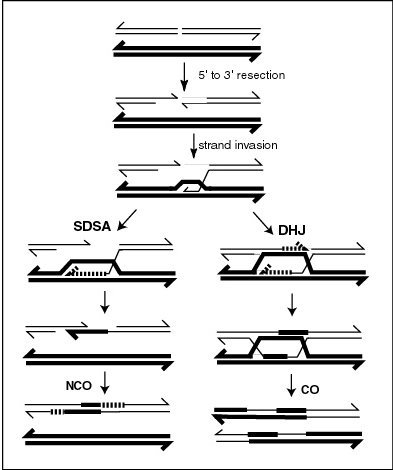Crossover Interference on:
[Wikipedia]
[Google]
[Amazon]
Crossover interference is the term used to refer to the non-random placement of crossovers with respect to each other during 
meiosis
Meiosis () is a special type of cell division of germ cells in sexually-reproducing organisms that produces the gametes, the sperm or egg cells. It involves two rounds of division that ultimately result in four cells, each with only one c ...
. The term is attributed to Hermann Joseph Muller
Hermann Joseph Muller (December 21, 1890 – April 5, 1967) was an American geneticist who was awarded the 1946 Nobel Prize in Physiology or Medicine, "for the discovery that mutations can be induced by X-rays". Muller warned of long-term dang ...
, who observed that one crossover "interferes with the coincident occurrence of another crossing over in the same pair of chromosomes, and I have accordingly termed this phenomenon ‘interference’."

Meiotic
Meiosis () is a special type of cell division of germ cells in sexually-reproducing organisms that produces the gametes, the sperm or egg cells. It involves two rounds of division that ultimately result in four cells, each with only one copy ...
crossovers (COs) appear to be regulated to ensure that COs on the same chromosome
A chromosome is a package of DNA containing part or all of the genetic material of an organism. In most chromosomes, the very long thin DNA fibers are coated with nucleosome-forming packaging proteins; in eukaryotic cells, the most import ...
are distributed far apart (crossover interference). In the nematode worm ''Caenorhabditis elegans
''Caenorhabditis elegans'' () is a free-living transparent nematode about 1 mm in length that lives in temperate soil environments. It is the type species of its genus. The name is a Hybrid word, blend of the Greek ''caeno-'' (recent), ''r ...
'', meiotic double-strand breaks (DSBs) outnumber COs. Thus not all DSBs are repaired by a recombination process(es) leading to COs. The RTEL-1 protein is required to prevent excess meiotic COs. In ''rtel-1'' mutants meiotic CO recombination is significantly increased and crossover interference appears to be absent. RTEL1 likely acts by promoting synthesis-dependent strand annealing which results in non-crossover (NCO) recombinants instead of COs (see diagram). Normally, about half of all DSBs are converted into NCOs. RTEL-1 appears to enforce meiotic crossover interference by directing the repair of some DSBs towards NCOs rather than COs.
In humans, recombination rate increases with maternal age. Furthermore, placement of female recombination events appears to become increasingly deregulated with maternal age, with a larger fraction of events occurring within closer proximity to each other than would be expected under simple models of crossover interference.
High negative interference
Bacteriophage T4
High negative interference (HNI), in contrast to positive interference, refers to the association of recombination events ordinarily measured over shortgenomic
Genomics is an interdisciplinary field of molecular biology focusing on the structure, function, evolution, mapping, and editing of genomes. A genome is an organism's complete set of DNA, including all of its genes as well as its hierarchical, ...
distances, usually within a gene
In biology, the word gene has two meanings. The Mendelian gene is a basic unit of heredity. The molecular gene is a sequence of nucleotides in DNA that is transcribed to produce a functional RNA. There are two types of molecular genes: protei ...
. Over such short distances there is a positive correlation (negative interference) of recombinational events. As studied in bacteriophage T4 this correlation is greater the shorter the interval between the sites used for detection. HNI is due to multiple exchanges within a short region of the genome during an individual mating event. What is counted as a “single exchange” in a genetic cross involving only distant markers may in reality be a complex event that is distributed over a finite region of the genome. Switching between template DNA strands during DNA synthesis (see Figure, SDSA pathway), referred to as copy-choice recombination, was proposed to explain the positive correlation of recombination events within the gene. HNI appears to require fairly precise base complementarity in the regions of the parental genomes where the associated recombination events occur.
HIV
Each human immunodeficiency virus (HIV
The human immunodeficiency viruses (HIV) are two species of '' Lentivirus'' (a subgroup of retrovirus) that infect humans. Over time, they cause acquired immunodeficiency syndrome (AIDS), a condition in which progressive failure of the im ...
) particle contains two single-stranded positive sense RNA genomes. After infection of a host cell, a DNA
Deoxyribonucleic acid (; DNA) is a polymer composed of two polynucleotide chains that coil around each other to form a double helix. The polymer carries genetic instructions for the development, functioning, growth and reproduction of al ...
copy of the genome is formed by reverse transcription
A reverse transcriptase (RT) is an enzyme used to convert RNA genome to DNA, a process termed reverse transcription. Reverse transcriptases are used by viruses such as HIV and hepatitis B virus, hepatitis B to replicate their genomes, by retrot ...
of the RNA genomes. Reverse transcription is accompanied by template switching between the two RNA genome copies (copy-choice recombination). From 5 to 14 recombination events per genome occur at each replication cycle. This recombination exhibits HNI. HNI is apparently caused by correlated template switches during minus-strand DNA synthesis. Template switching recombination appears to be necessary for maintaining genome integrity and as a repair mechanism for salvaging damaged genomes.
References
External links
*{{Commons category-inline, Genetic interference Cellular processes Molecular genetics